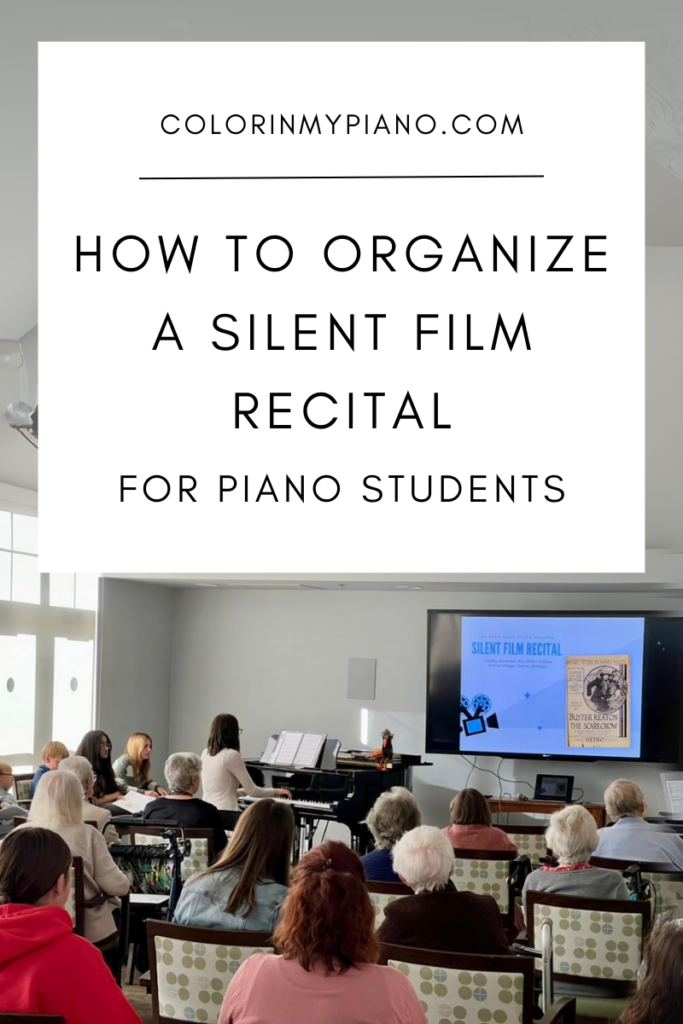
As mentioned previously, my students and I successfully presented a Silent Film Recital a couple of months ago. (Highlights and photos here!)
As promised, I’d like to share the details of how we did it and give you a guide on how to plan your own Silent Film Recital. The process was so much fun from beginning to end, and I definitely recommend it to other piano teachers looking to spice things up with a unique recital format that is memorable and fun.
In this article, I’ll first share how I became interested in organizing a silent film recital. Then, we’ll discuss the following steps for organizing a silent film recital for your piano students: (1) Selecting a Film, (2) Sourcing the Music, (3) Matching Music to the Film, (4) Preparing Students, and (5) Hosting a Silent Film Recital.
The Backstory
Have you ever attended a silent film showing? My first time was around 2013, when a piano teacher colleague was performing during a silent film showing at a local historic opera house. Curious to experience this blast from the past, my husband and I bought tickets and attended. We thoroughly enjoyed the experience!
I love history, so naturally I was intrigued to learn more about silent film accompaniment. Silent films hold a special place in the history of cinema as a pioneering art form for storytelling through visuals and music. In the early 1900s, theaters popped across the U.S. as this new form of entertainment became popular. Musicians provided live accompaniment for silent films using organ, piano, or a small orchestra. In the late 1920s and 30s, things changed when technological advancements allowed dialogue/music to be captured along with the picture and “talkies” took over. Nevertheless, silent films continue to captivate audiences to this day.
Over the past few years, I’ve been following the work of a colleague by the name of Heather Smith, a piano teacher in Centerville, Utah, sharing about how she has organized silent film projects for her piano studio as well as her local music teachers association. Intrigued by the idea, I was excited to see her Spring 2023 launch of SilentFilmCelebration.com — a non-profit dedicated to providing resources for piano teachers to organize their own silent film accompanying events. So, earlier this year I decided to take the plunge and try this as a project with my piano students using Heather’s resources (which I will be mentioning further throughout this article).
1. Selecting a Film
I’d say the first step to organizing a Silent Film Recital for your piano students is to choose a film. There are a variety of historic silent films from the 1900s to explore, but you won’t get far in your research without encountering the greats Buster Keaton and Charlie Chaplin. Keaton and Chaplin were both masters at comedic films, many of which are good options for a family event with students.
At SilentFilmCelebration.com, Heather has made available for purchase a handful 2-reel, 20-minute comedy films, with plans to add gradually add more. I suggest previewing the films yourself first (on YouTube) before purchase to decide which one you’d like your students to work with. You’ll need to decide whether you want to showcase one or two films during your event, and whether to allow time for your students to perform solo repertoire as well (perhaps with a film-inspired theme). Another idea worth consideration is to collaborate with another local teacher or a music teacher association to make it a larger event.

With this being my first time attempting this project, I decided to work with just one 20-minute film rather than two. I selected Buster Keaton’s “The Scarecrow” — a film from 1920 about two farmhands who live in a home with lots of fabulous gadgetry and both have a crush on the farmer’s daughter. It’s a funny film with a lot of action that happens in just 20 minutes.
When you purchase a film through SilentFilmCelebration.com, it comes with an outline dividing the film into about 20 “chapters” or scenes. This means if you give each student one scene, you can involve up to about 20 students.
If you don’t have exactly 20 students, there are ways you can involve more or fewer students. For example, you can break the scenes into smaller segments or have a few students play a prelude or postlude before/after the film. If you have fewer than 20 students, you can very easily have a few students play for two scenes. Most of my older students played for two or three scenes (either consecutively or they played at multiple points during the film). I played for a few of the scenes myself as well, which I thoroughly enjoyed.
2. Sourcing the Music
When silent films became popular in the early 1900s, there was suddenly a market for sheet music for pianists, organists, or small orchestras to play during silent film showings. Composers and publishers responded by releasing volumes of pieces with titles such as “Hurry Music,” “General Use,” “Dramatic Tension.” Pianists could purchase these volumes to incorporate into their silent film accompanying, perhaps alongside their own improvisations. This music is often referred to as “incidental music,” because it is music not intended to be the primary focus; it is meant to enrich and augment the silent film-goer’s experience without calling undue attention to itself.
The book pictured below with the beautiful red cover is an antique from 1913 from my personal music library. As the title indicates, it is a volume of incidental music composed for silent film accompaniment. I’ve had this book on my shelf long enough that I don’t remember where it came from, but I’m guessing it came from either a thrift shop or a box of music from a retired piano teacher. Flipping through the book, you’ll see fun titles such as: “Explosion or Fire Scene” or “Burglar or Sneaky Music.” 🙂
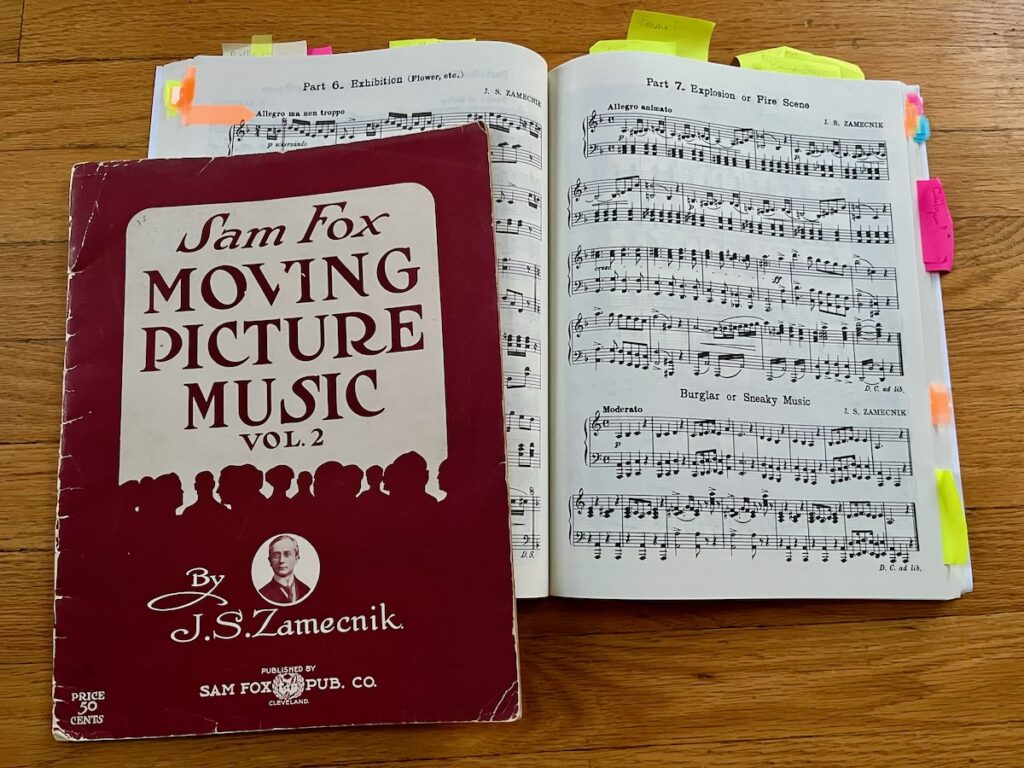
While practically ANY piano literature source is fair game for silent film accompaniment today, I do think it’s worthwhile and fun to search out some historic silent film music for at least some of your students to play. Fortunately, you don’t have to go antiquing to find it. There are both online and hardcopy sources available today for acquiring historic silent film music.
Historic Incidental Music for Silent Films
Below is a list of sources where I found historic incidental music for silent films to use with my students. I thoroughly enjoyed researching silent film music original to the early 1900s and finding pieces appropriate for my intermediate and advancing students — and I bet you will, too.
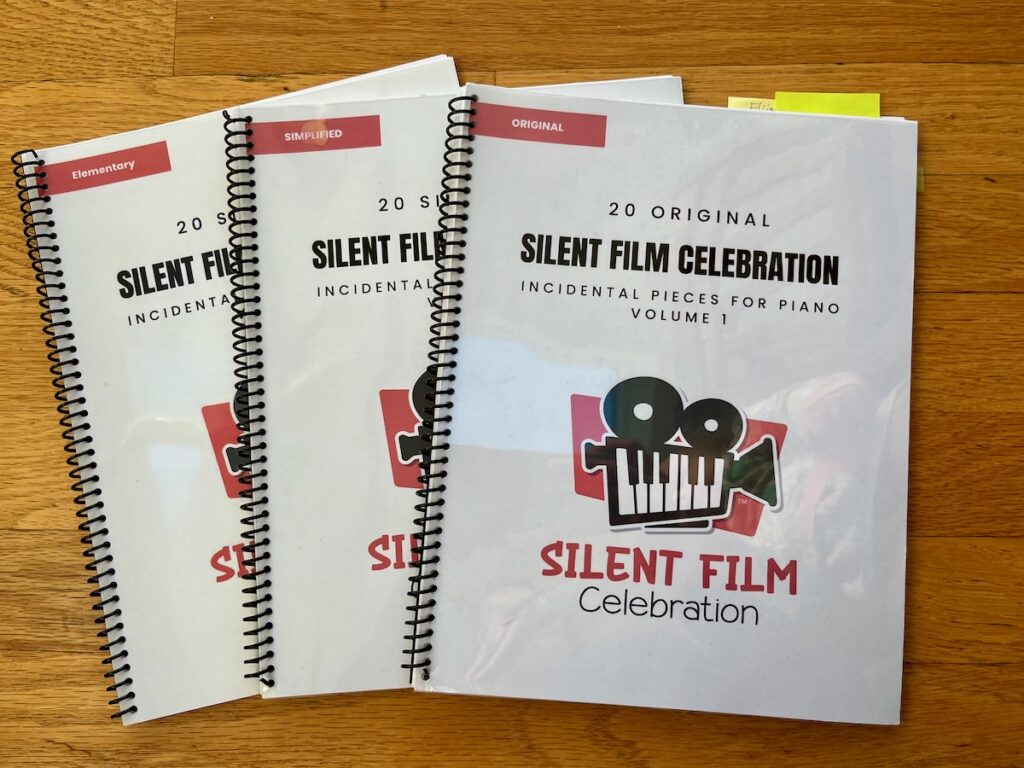
- SilentFilmCelebration.com’s Studio-Licensed PDFs: At SilentFilmCelebration.com you can purchase not only silent film videos, but also studio-licensed PDFs of incidental music here. To date, there are three collections available. The “Original” book is a compilation of 20 pieces taken from the public domain (meaning, the copyright has expired, at least here in the U.S.) by various composers — all in original form, but newly engraved. The “Simplified” book contains the same 20 pieces, but arranged to an intermediate level. The “Elementary” book again contains the same 20 selections, but arranged to an elementary level (late elementary, IMO). I printed out my studio-licensed PDFs and bound them using my spiral binding machine to create my own reference copies (pictured above). Thanks to the studio license, I can print pieces out for my students as needed.
- Public Domain Websites: PDFs of public domain sheet music can be found online on a variety of websites. One is IMSLP.org, and another is sfsma.org. I spent time on these sites browsing and searching using keywords such “incidental music,” “silent film,” “moving picture,” “motion picture,” etc., and was able to find a variety of useful collections to use with my students or play myself. While most of this music is at an advanced or late intermediate level, you can find the occasional piece that is easier.
- Hardcopy Books: There are books available for purchase that compile historic silent film music. One such anthology is a Dover publication called Sounds for the Silents, edited by Dr. Daniel Goldmark, which includes collections by composers such as J. S. Zamecnik (including the antique book I mentioned earlier), M. L. Lake, Joseph Carl Breil, J. Bodewalt Lampe, and Walter C. Simon. Even though most of these collections are also available as a free download on public domain websites, but I found it convenient to have them in hardcopy book form so I could easily explore and sightread them. Another anthology I purchased is The Music of the Silent Films, compiled by Ben Model. It features 50 individual pieces (rather than full collections) by various composers. While both anthologies are useful, the Dover Sounds for the Silents is a particularly great value — especially because I was able to find quite a few pieces that were simple enough for intermediate students. The other publication is nice to have if you want more pieces and if you think you’d enjoy the essays and photographs provided at the beginning of the book. With both books, I found that I was generally able to go to IMSLP.org and find a public domain PDF to legally print out my students’ selected pieces (rather than ask students to purchase the entire book).
(PS: This blog post contains Amazon Affiliate links. Thanks for supporting my work!)
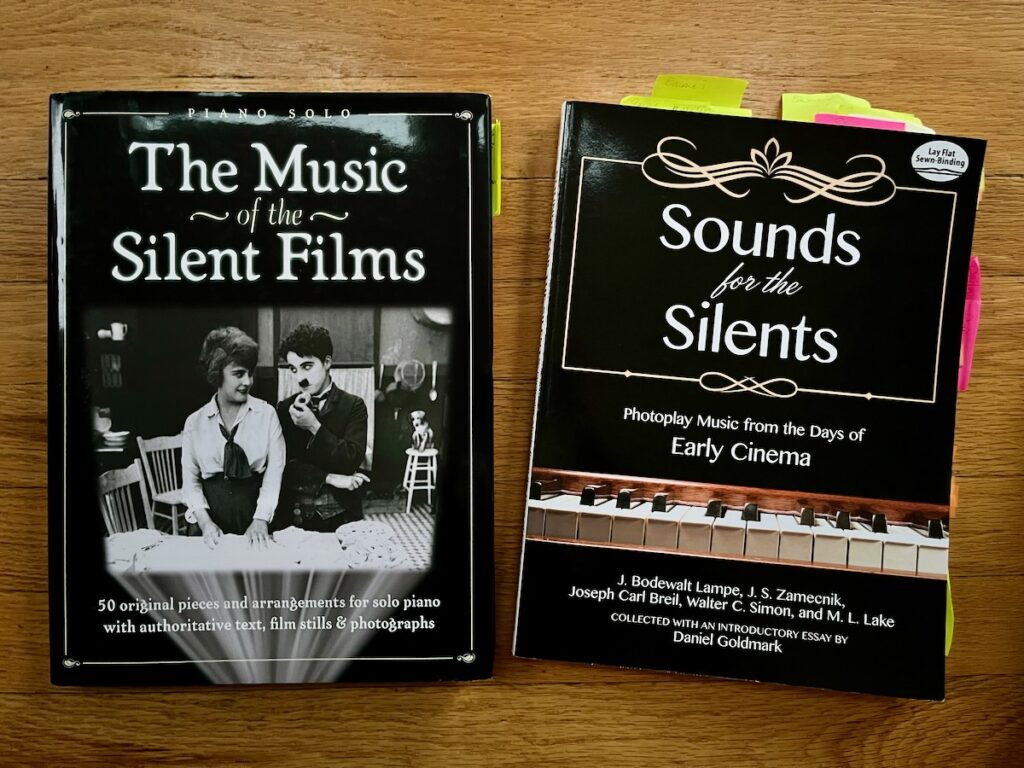
Other Music for Accompanying Silent Films
While using historic incidental music is the ideal (at least in my mind) for a project like this, I quickly learned it was not practical to expect to find something in that vein for every one of my students — particularly the younger ones. Historic silent film music was not composed for developing students. The difficulty level is what we’d consider today to be an advanced or late-intermediate level. While you might be able to find a few pieces for mid-intermediate students, you will need to turn to other sources to find pieces for your beginner, elementary, and early-intermediate students.
There are no real rules about what music you can and can’t use for a silent film project with your students. However, I personally prefer to stay away from music that is highly recognizable (such as Für Elise, Moonlight Sonata, or movie themes like Star Wars), because it pulls the audience’s attention away from the film. I suggest also avoiding music that adds outside commentary or humor — such as playing your favorite sports team’s fight song during a sporting scene. To give justice to the film and deliver a more authentic viewing experience, the goal is for the music to facilitate and add to the viewer’s experience of the film.
Other than that, pretty much anything goes. Your students can perform practically any piece of music, as long as it fits the mood of the scene. Ragtime music works great for general action scenes. Classical repertoire can be used for a variety of moods, as can the pedagogical music of recent or living composers.
Some of my students selected new pieces with our silent film recital in mind, while others were able to use pieces from their current or past repertoire. Some of my youngest students used pieces from the method book they are currently working through.
Improvisation is also an option. I had one student improvise based on a simple theme and chord progression from a video game. It was music that is not generally recognizable by the public, and the mood fit perfectly with the scene. I was very pleased with his idea and execution!
Keep in mind that the scenes are short, so your students might not need their pieces in their entirety. Long pieces may need to shortened. On the other hand, short pieces may need to be repeated multiple times or extended in some other way. (More on dealing with timing later.)
Below is a short list of example sources for finding music suitable for beginner and elementary students for silent film accompaniment. This is far from a complete list, because as I said earlier, pretty much “anything goes” as far as sources go for silent film accompaniment. But I hope this list will give you ideas for a few places to get started!
A quick note about Music Licensing: Before reading on, it might be helpful to be aware of music licensing ramifications that apply should you decide to hold your Silent Film Recital as a public event (e.g., held at a public venue, open to the public, and/or with tickets sold) as opposed to a private event for your studio families. In the case of a public event, copyright laws dictate that music licensing must be acquired (and fees paid) for any performed music that is under copyright. You may want to keep this expense in mind as you plan your event. Music with copyrights expired in your country, however, are considered "public domain" and music licensing is not required to perform that music in public. That said, if your recital is a private event for your studio families, you shouldn't need to worry about licensing -- at least, by my understanding (I'm not a lawyer). Read more about this in MTNA's helpful article, MTNA Copyright Guidelines for Music Teachers, and scroll down to the section about "Recitals and Recordings."
- Jazz, Rags, and Blues, Books 1-6, by Martha Mier — These books have become classics for a reason: they contain great pieces students and teachers love! These pieces, especially the ragtime-style ones, are perfect for silent film accompaniment. Find them at Amazon, Sheet Music Plus, or your favorite local music shop.
- Chrissy Ricker’s music — Chrissy Ricker is a master at composing pedagogical music, especially for late elementary and early intermediate levels. For example, take a look at her Perfect Patterns series — particularly her Easy Perfect Patterns book (Late Elementary), which has some great selections for “hurry music” or for “general action” scenes. (Thanks goes to my friend Lynnette for pointing me to this series.) But all of Chrissy’s music is great. You can find her music available as hardcopy books and Studio-Licensed PDFs at PianoPronto.com. If you haven’t checked out her music before, you are in for a treat. (PS: Visit her website and join her email list here.)
- The Big Digital Ragtime Book, by Carol Matz — This is a new release from composer Carol Matz featuring 25 arrangements of rags by Scott Joplin, Joseph F. Lamb, Harry P. Guy, and more for Late Elementary to Mid-Intermediate level students. This PDF is an especially great value since it includes a Studio License permitting the purchasing teacher to print at needed for their students. Check it out here.
- Incidental Music for Piano: 12 Extendable Pieces for the Young Silent-Film Pianist, by Joy Morin (yours truly!) — I composed these pieces with elementary level students in mind. Each piece is titled to convey a specific mood or character, so you can match the music to a suitable scene in the silent film you’ve chosen. Sections within the pieces can be repeated or omitted, granting creative freedom to structure each piece according to your artistic vision and the time allotted. The provided Music Planning table allows you to make record of your plan. My students loved playing these, and I hope yours will too! Available now as a Studio-Licensed PDF or a hardcopy book. I’ll share more about this new book in a future blog post, since there is much more I would like to say about these pieces! Update: Please read more about and hear recordings of my compositions here!


Once you’ve explored a variety of music to use with your students, you can begin sharing options with your students and deciding when to have them play during the film.
3. Matching Music to the Film
As I mentioned earlier, when you purchase a silent film video from SilentFilmCelebration.com you’ll also receive an outline that divides the film into about 20 scenes. Each scene is listed with a mood or “theme”; for example: hurry, dramatic tension, general use/action, love, etc.. These descriptions help you and your student match music appropriately to each scene.
So, how do you decide which students will play which scenes and which music selections?
The answer is: You figure it out little by little! I kept my outline close at hand during piano lessons and updated it with student names and piece titles as the days and weeks went by.
I initially announced our silent film project to parents via email. During lessons, I told each student about the project and showed them the outline of scenes. I demonstrated at least two or three pieces of appropriate difficulty level. I was pleased at how delighted my students were by the titles of the historic incidental music — and the music itself, of course. We worked together to select a piece that appealed to them and then decide where it would fit within the film.
Some students learned their piece quickly, so I was able to assign another piece for a second scene. I played for a few remaining unclaimed scenes, which I thoroughly enjoyed doing!
4. Preparing Students
Early on in the project, I highly recommend hosting a “watch party” at your home or studio so your students can preview the film together. This really made the project come alive and got my students excited about presenting this as a recital for friends and family. I don’t think any of my students had ever seen a silent film from the early 1900s before. A couple of my students were laughing pretty hard about certain scenes. I didn’t plan anything elaborate; we just popped popcorn together and then watched the film in my living room.
Most of the scenes in SilentFilmCelebration.com’s outline, as I mentioned earlier, are around a minute in length (between 0:40 and 1:20). This means students who have chosen longer pieces will not need to play their entire piece. And students with short pieces might need to repeat it two or three times.
Once my students were able to play their piece up-to-tempo, we timed their performances using my phone’s stopwatch. This helped us decide what sections to repeat or leave out. We made indications in the score using pencil, while recognizing this approximation would depend on the tempo taken during performance and timing of the students playing before and after. I encouraged students to become comfortable stopping anywhere in the piece, even mid-measure. (Personally, I think the transitions between students sounded better without necessarily hearing a final cadence at the end of each piece.) I also encouraged students that it was okay to “interrupt” and start playing when they see their cue even if the previous student hasn’t quite finished playing yet. A little bit of overlap sounds okay.
Three or four weeks before the event, I started playing the film on my laptop during each lesson while students played their pieces. This allowed them to get accustomed to watching for their scene’s START and STOP cues while performing. This isn’t as difficult to do as it might sounds, but it does take a little practice.
Here’s how we practiced this. First, we watched the segment of film associated with their scene. We wrote down the timestamp for their assigned scene at the top of their sheet music. Then I asked the student to write down their cues — that is, short descriptions of what to watch for in the film so they know when to start and stop playing their piece. For example:
13:48 Scarecrow Scene
START: See scarecrow.
STOP: Girl walks to river and kicking scene starts.
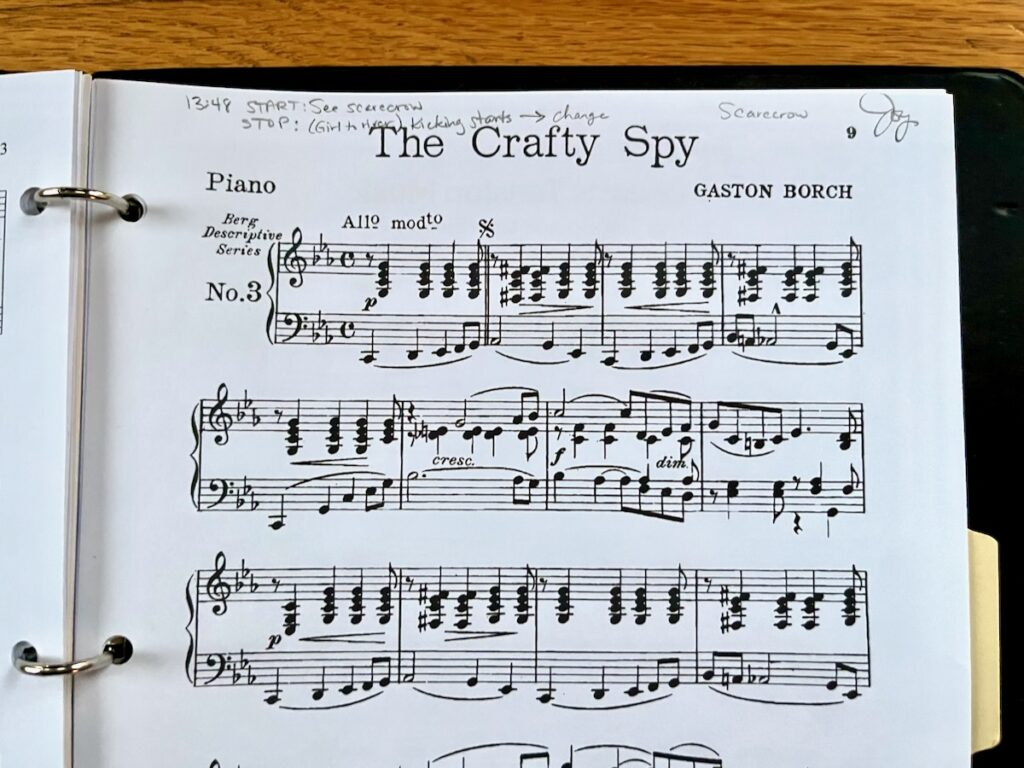
Each lesson, I asked them: “So, what are your cues again?” And they told me verbally before they practiced accompanying their scene.
I encouraged students to practice this process at home at well, and some of them did. Regardless, I made sure we practiced enough times during lessons that I felt confident they could do it well — whether or not they took the time to practice along with the film at home.
If possible, you may wish to host a group rehearsal for your Silent Film Recital. I did, although I didn’t have a great turnout. It’s tricky getting everyone’s schedules to align, and I was already asking for a lot of time from them. So, I was glad I had each student practice their scene with my laptop plenty of times during lessons. Our recitals went very smoothly. Next time, I probably won’t worry about holding a group rehearsal and instead just practice thoroughly individually again. But that’s just me — you might find a group rehearsal essential.
By the way, I’d highly recommend gradually assembling a “master binder” for yourself as facilitator. I came up with this idea about halfway through the process, and am so glad I did. Basically, I made reference copies of each student’s piece(s), notated their START and STOP cues, and placed them in order in a binder. This gave me an easy way to follow along on performance day. It also gave me peace of mind knowing that if a student fell ill at the last minute, I could easily fill their role. (As always, please observe copyright when it comes to copying sheet music. As I understand it, personal reference copies can be made legally if you do own the original scores and if you destroy them after use.)
5. Hosting a Silent Film Recital
When it comes to choosing a venue, the most important consideration is that you need two pianos and either a large TV or projector with screen. As I mentioned in my initial blog post about this, I actually ended up hosting three Silent Film Recitals due to the locations of my students and my desire to bring our recital to a local retirement center.
Churches, retirement centers, and local theaters are examples of suitable venue options to consider. I used my laptop to play the film, and was able to connect to either a TV or my projector with an HDMI cable. I brought in my own digital piano to use alongside the piano already at each venue. I also brought along two gooseneck reading lights (from my husband’s and my nightstands), to make sure the music was well-lit even with the overhead lights dimmed for the film.

I wanted for this event to feel like a fun and informal to my students, and for attendees to feel like they were at the movies. I considered renting a popcorn machine, but ultimately decided to purchase snack-sized bags of pre-popped popcorn (I ordered these in white cheddar and butter) for easy serving and clean-up. I also put out a bowl of fun-sized candy bars and small bottles of water. (This was for our recital at a church venue. I did not serve refreshments at the retirement center.)
I kept the decorations simple. I put this clapperboard prop out on a table alongside my silent film music books. I also printed out an old movie poster image for the film we were showing (pictured below). There are many options for movie-themed disposable dinnerware/party favors, and balloons would also be fun. It’s up to you how involved you want to get with decorations and so forth. It’s certainly not necessary, but can be a fun touch if that’s something you enjoy doing.

I normally allow students to sit with their families during recitals, but I thought the scene transitions might be smoother if students sat in order in the front row. So, I saved a spot for each student to sit, marked by a recital program with each student’s name written at the top. This helped students know when it was their turn to be “on deck” at the empty piano to get ready to play.
Before the recital began, I provided a brief introduction to our project and the film itself, sharing a brief historical context and a synopsis of the film. I felt that the film made more sense with at least a short introduction, and families would appreciate the film more after hearing some history of the silent film phenomenon.
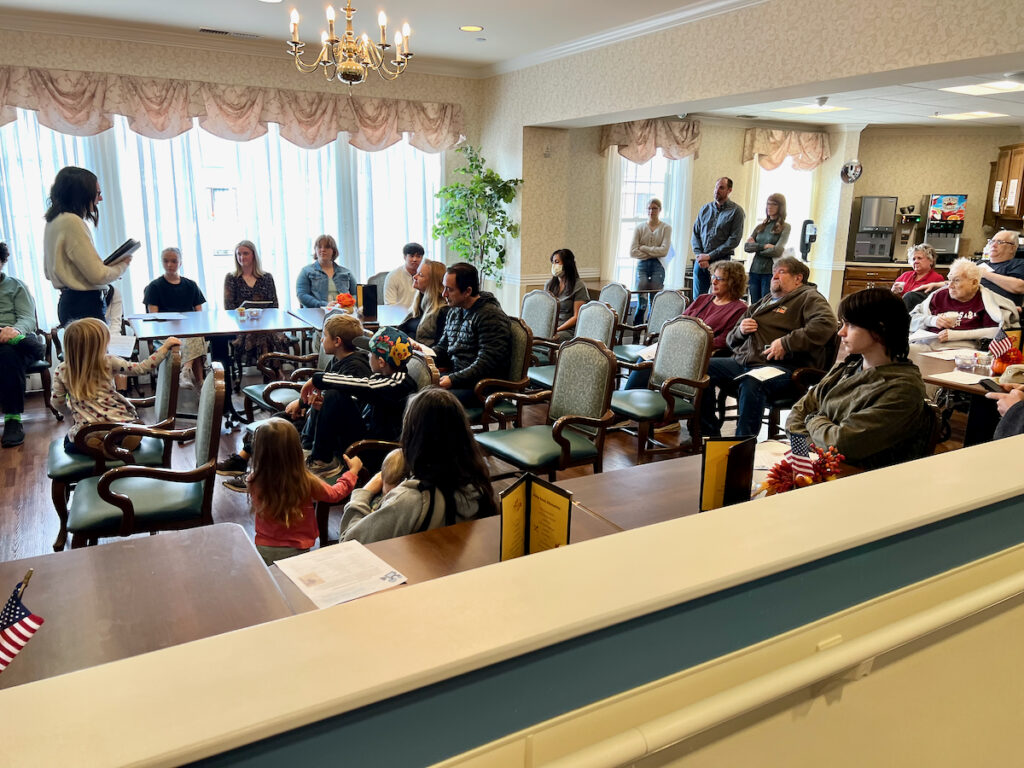
The recital program was also a helpful guide for everyone to know what to expect. Here’s a peek at the program I created.
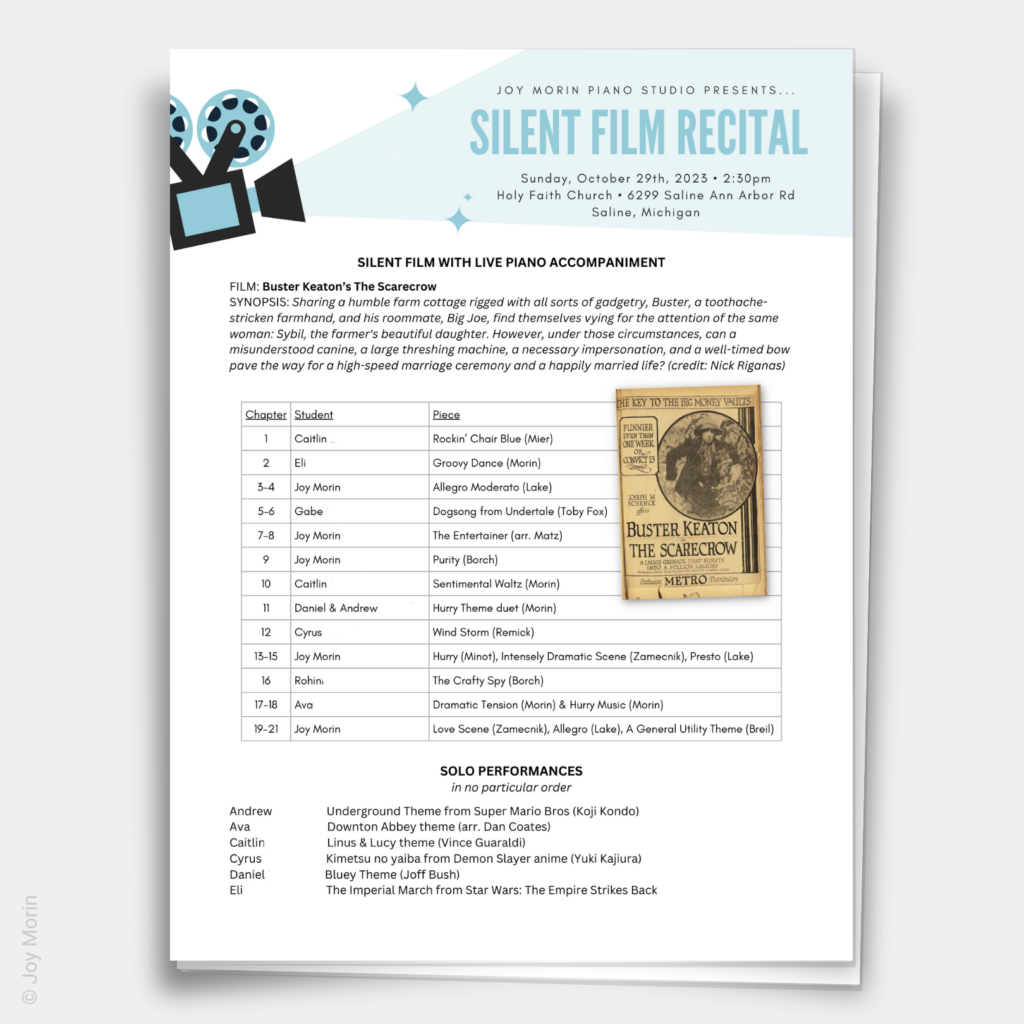
As you can see, I created a table to list the scenes or “chapters,” students, and their music selections. Because this was a smaller group of students and we only showed one 20-minute film, we supplemented our recital program with some solo performances at the end. I encouraged students to play arrangements of movie, TV, or video game themes.
In the spirit of keeping the performance informal and low-pressure, I created a silent film quiz for students and families to work together on during the solo performances. It consisted of 12 questions based on facts I found online about Buster Keaton and silent films. The family who answered the most questions correctly won a prize — a gift basket containing a gift certificate to our local movie theater, microwave popcorn, candy, and a few other goodies.
This idea worked better than I imagined. I was pleased to see families huddle together to circle their best guesses on the quiz (no internet searching allowed!), and students seemed very comfortable walking up to the piano themselves to play when they were ready as background music. After about 15 minutes, I led everyone through the correct answers and gave the prize to the winning family.
I plan to share printable templates of the recital program, quiz, and more that I created, in case you’d like to edit and use them yourself. Because this article is getting long enough, stay tuned for those resources in another post coming soon. UPDATE: Here is the blog post where you can download my Printables for Your Silent Film Recital!
Conclusion
I was really happy with how our Silent Film Recital event went, as well as the project as a whole. I found it valuable for my students to encounter historic silent film music, learn how accompany a film, and enjoy presenting the film with music for their friends and family.
One of my personal goals as a teacher (especially post-Covid) has been to make sure I provide enough performance opportunities for my students throughout the year — specifically, informal performance opportunities. I think performing can feel nerve-racking when it’s something you rarely do; however, when you do it frequently, especially in friendly environments, it becomes less of a big deal. I have experienced both ends of this spectrum myself, both as a kid growing up and during my college years. The more often I played for others, the more comfortable I felt doing so.
Our Silent Film Recital project aligned well with this goal of mine as a teacher, because the audience’s focus was primarily on the film. I think my students enjoyed their role providing background music, and it felt great hearing the audience laugh and enjoy the film.
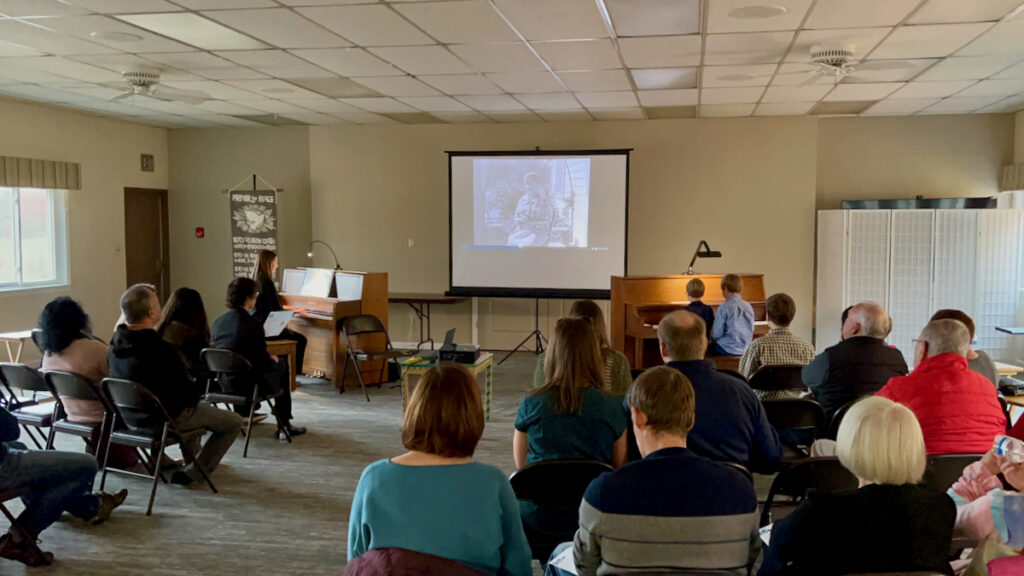
I asked parents for feedback on what they thought of the event, and I heard back from several saying they found it fun to attend and they’d love to see their students do it again in the future.
All in all, it was a memorable experience. I’m already looking forward to doing another Silent Film Recital, next time with a different film. At this point, I’m thinking I’d like to make it an every-other-year tradition, opposite against a Halloween recital (another type of recital I’ve always wanted to do).
I hope this article has been interesting and helpful, especially if you’re thinking about organizing your own Silent Film Recital for your students. Thanks for reading!
Your turn: Have you ever attended or accompanied a silent film before? Are you interested in organizing your own Silent Film Recital? What questions do you have about the process? Do you have sources to recommend for finding music for silent film accompaniment? Leave a comment below. I’d love to hear from you!

